Dominant & Recessive
It bears restating that every gene in every chromosome of the Rock Dove is accepted as a standard issue! Each of the thousands of genes combine to produce the rock dove. Until a mutation is identified all genes are declared wildtype genes; and are labeled with "+", the symbol for wildtype.
When a characteristic is identified that is not found in the wild type, a tentative symbol is assigned to that variation (mutation). Breeding tests are necessary to determine if the characteristic is a dominant, a recessive, or a combination affect of more that one genes actions.
The concept of a dominant gene is - one that has some control over the actions of the opposing wildtype gene (allele) on the adjoining chromosome - therefore, altering the outward appearance (phenotype) of the wild type.
Conversely, a recessive gene - has no control over the actions of the opposing wildtype gene (allele) on the adjoining chromosome - therefore, the outward appearance (phenotype) of the wild type remains unchanged.
For a cartoon grapic depicting dominance and recessiveness, click here.
Generally, a mutant gene (one that has changed from wildtype) is either a dominant gene or a recessive gene. Excepting for sex-linked genes, if the action of a single gene is detectable in wildtype it is considered a dominant; and if it is not detectable it is considered a recessive. It must be well understood that dominant and recessive are terms used primarily to describe a single genes expression on wildtype. Although they are often used to compare one mutant to another, at a given locus; (e.g., checker is dominant to barless).
Both almond and faded are dominant genes; (dominant to wildtype). Though almond may be described as being dominant to faded; and faded as being recessive to almond, it has no bearing on their classification on wildtype. Wildtype (+) is neutral or standard; neither dominant or recessive to other genes. Instead, other genes are dominant or recessive to wildtype. A classification of "dominant" or "recessive" is based on the action of a gene when opposed by a wildtype gene; and not the action of a mutant gene when opposed by another mutant gene. Only when opposed by a wildtype allele are the terms "dominant" and "recessive" used to classify mutant genes.
All dominant gene symbols begin with capital, or upper case letters, (A, B, C, etc.); and all recessive gene symbols begin with lower case letters, (a, b, c, etc.). (Figure 1.)
 Figure
1.
Figure
1.
-- Symbols for dominant genes - almond, faded, qualmond and ash-red
- begin with upper case letters. Symbols for recessive genes - dilute,
dilute-pale, reduced, web-lethal and brown - begin with lower case letters.
 * * Index
* *
* * Index
* * 